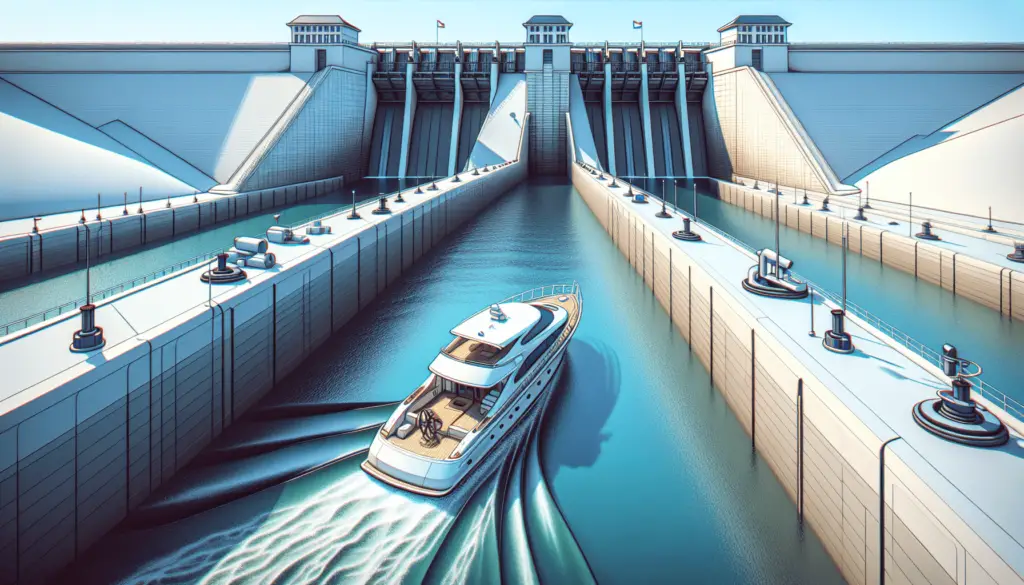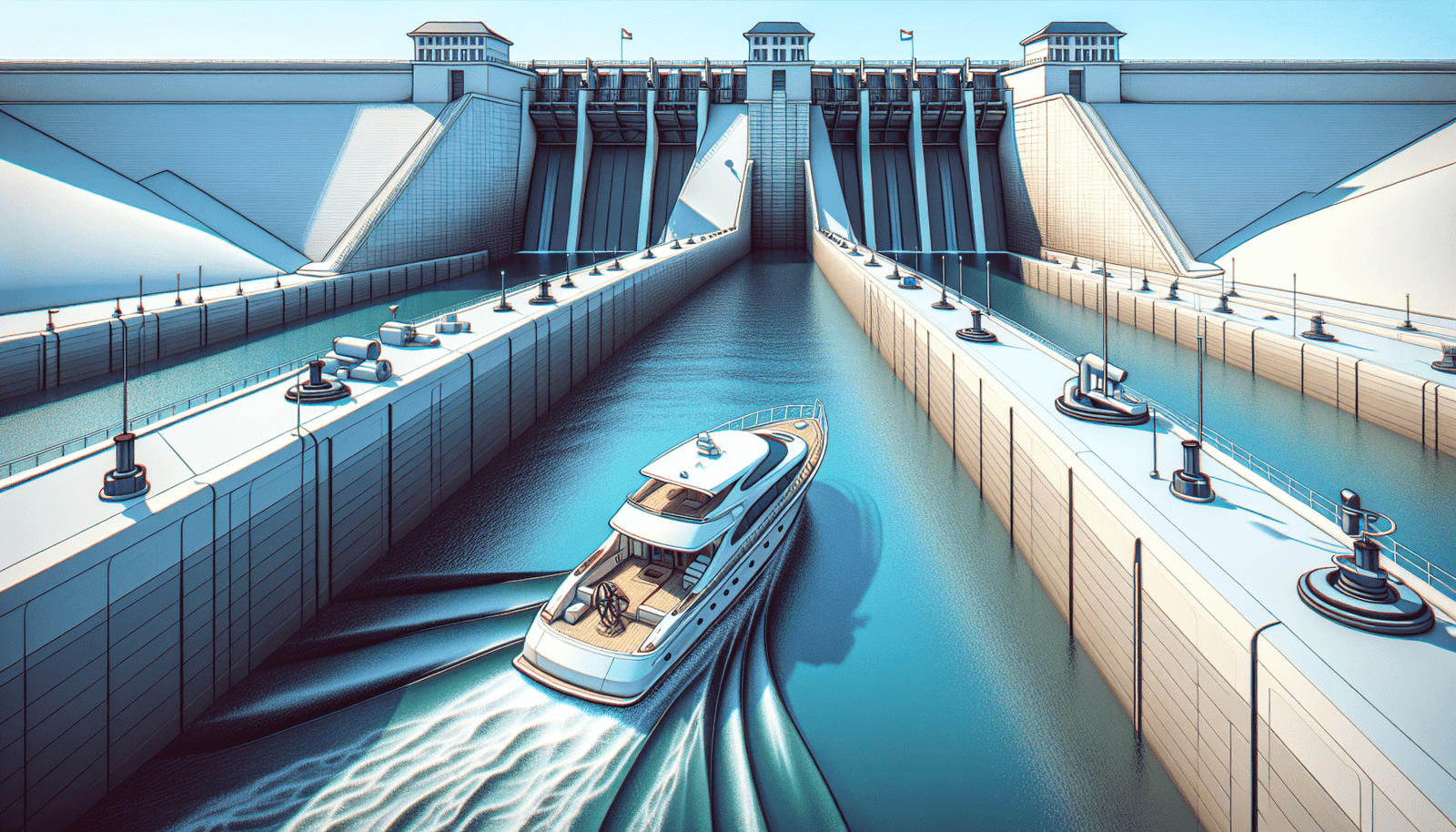For all you aquatic adventurers who brave the ever-changing waters, this is for you – a guide on Boating Safety at Dams and Locks. Picture this, the sun is shining while you captain your vessel through shimmering waters. But, those waters hold potential danger at their most unassuming locations – within the heart of dams and locks. This article sails through the sea of information, guiding you on how to navigate these treacherous zones with safety and finesse, ensuring your boating story continues to capture the thrill of adventure with the assurance of security.
Understanding Dams and Locks
From the time you first set your eyes on a seemingly tranquil body of water, ready to cast off with the enthusiasm of a seasoned sailor, it’s easy to underestimate the mammoth power of dams and locks. But they are much more than mechanisms that merely regulate water flow or giant barriers of steel and concrete – they are intricate systems that have shaped entire waterways and have thus had critical roles in the history of navigation.
Overview of dams: purpose, design and potential dangers
Dams are titans of engineering, ancient examples of human ingenuity and perseverance. Designed to contain, redirect, or block the flow of water, dams serve various crucial purposes, from generating hydroelectric power, providing water for irrigation, to facilitating navigation, among others. As grand as these purpose-built structures are, their potential dangers are equally as formidable. From flooding caused by dam failure to turbulent undertows, dams can pose significant risks to unsuspecting boaters.
Essence of locks in water management systems
Their less intimidating counterparts, locks, are an integral component of many water management systems, playing a vital role in making rivers and canals navigable. Acting as water elevators, locks help vessels to gracefully navigate changes in water levels. Without them, arduous and treacherous water routes would become unmanageable or impassable, making these often overlooked structures invaluable to the boating world.
Role of dams and locks in boating
For boaters, dams and locks present both opportunities and challenges. They offer the chance to navigate waters that would otherwise remain inaccessible, opening up new possibilities for exploration. However, they also require a certain level of knowledge and skill to navigate safely. Misuse of or disrespect for these structures can lead to severe, even catastrophic, consequences.
Preparation Before Boating Around Dams and Locks
Stepping into the waters near dams and locks requires a strong emphasis on safety and proper preparation.
Research about local dams and locks before the trip
A knowledgeable boater is a safe boater. Before setting off, it’s essential to research local dams and locks, gaining an understanding of their operation, locations, and any associated hazards. This knowledge will help you to anticipate and avoid potential problems during your journey.
Inspecting boating equipment for reliability
Next, it’s vital to ensure the reliability of your boating equipment. A thorough inspection could be the difference between a successful trip and one that ends in disaster. Keep a keen eye out for any signs of wear and tear or potential malfunction.
Pack necessary safety equipment
Life jackets, first aid kits, flares, sturdy ropes, and sufficient food and water are a few of the essentials that should always find a place in your kit. Packing necessary safety equipment is far from a simple precaution – it’s a lifeline when things don’t go according to plan.
Check weather conditions
Lastly, weather conditions can drastically change the nature and difficulty of your journey. Accurate weather forecasts will help you decide the best time to set out and whether it’s safe to do so.

Operating Boats Near Dams
Understanding the correct approach when operating boats near dams is quintessential for a safe boating experience.
Speed and distance considerations near dams
Navigation near dams requires careful speed control and keeping enough distance. Dams can create unusual and dangerous water conditions, so reducing speed and maintaining a safe distance can prevent possible accidents.
Understanding the water flow near dams
The water flow near dams can be unpredictable and treacherous. Therefore, gaining an understanding of its patterns and potential hazards before you get on the boat can help anticipate and avoid potential accidents.
Safe practices when approaching a dam
Boaters must exercise caution when approaching a dam. Avoid attempting to cross a dam from above or below, and be sure to follow all marked navigation routes and safety guidelines.
Dealing with varying water levels and currents near dams
Water levels and currents can change rapidly near dams, leading to unstable and potentially dangerous conditions. Staying alert and responsive can make all the difference in navigating these waters.
Navigating Through Locks
Locks might look simple, but their operation is anything but, requiring a solid understanding and communication.
Knowing lock operation protocol
Educate yourself about the correct procedure to pass through the locks. It includes understanding the order of operations and the role of lock operators to ensure a smooth and safe transition through the lock.
Communication with lock operators
Effective communication with lock operators is crucial. They can provide important information about lock operations, water levels, and potential hazards. Show them respect and adhere to their directions – it could be a key element in maintaining your safety.
Control the boat properly while in the lock
While in the lock, maintaining control over the boat can be challenging due to changes in water levels. Knowing how to handle the boat in different water conditions is vital to prevent damages.
What to do in case of lock malfunction
In case of a lock malfunction, stay calm, and contact the lock operators. They will provide you with guidance on the necessary steps to take during such a situation.

Signs and Signals Near Dams and Locks
A boater’s guide to safety includes an in-depth understanding of various signs and signals near dams and locks, a language spoken by the waterways.
Interpreting warning signs and signals
Winged heralds of safety and threat, warning signs, and signals near dams and locks provide essential information for boaters. Understanding and adhering to what these markers communicate can save you from unfortunate incidents or complete disaster.
Understanding navigation buoys and their meanings
Navigation buoys serve to guide boaters, helping them chart a safe route through potentially treacherous waters. Acquaint yourself with these maritime signals so you can navigate with ease and assurance.
Response to audible warning systems
At times, audible warning systems may be in place near dams and locks. These alarms provide real-time alerts about potential risks or changing conditions and require immediate response.
Emergency Procedures
Despite the best-laid plans and precautions, emergencies might arise. Knowing how to respond can make a significant difference in the final outcome.
Actions in case of a boat capsize near a dam
If your boat capsizes near a dam, stay calm, and prioritize personal flotation. Attempt to reach the shore without approaching the dam. Being prepared with well-practiced emergency procedures can be a lifesaver.
What to do if swept towards a dam
Should you find yourself being swept towards a dam, your immediate response should be to move away from the dam and towards the shore as quickly and safely as possible. Don’t attempt to swim against the current; instead, allow it to carry you diagonally toward the shore.
Emergency contact information and communication
Always have crucial emergency contact information readily available. These include contact numbers for nearby local emergency services, the coast guard, and lock operating authorities.
Training and Education for Safe Boating
Training and education form the cornerstone of safe boating, particularly around dams and locks.
The significance of boating safety courses
Boating safety courses equip you with the knowledge and skills necessary to handle various situations, from navigation to emergency response. These courses are truly invaluable in fostering safer waterways.
Understanding content of boating safety manuals
Dedicate time to understand the content of boating safety manuals. They offer a plethora of critical information ranging from equipment checks to emergency procedures, all tailored to keep you safe on water.
Certification programs for boating near dams and locks
Completion of certification programs specific to boating near dams and locks demonstrates a high level of commitment to safety. These reputed programs ensure you are well prepared to face any challenges in these areas.
Boating Laws and Regulations
Rules and guidelines shape the framework within which we navigate our waters, promoting safety, fairness, and protection for all.
Local and federal boating laws
Every region will have specific local and federal boating laws that govern the operation and navigation of boats. Pay particular attention to laws regarding navigation around dams and locks, as non-compliance can lead to hefty fines or other severe penalties.
Legal consequences of unsafe boating practices
Reckless or unsafe boating practices can lead to significant legal repercussions, such as fines, suspension of boating privileges, or courtroom trials in cases of major incidents. Ignorance is not a defense in law, so knowledge of these consequences is key to promoting safe boating.
Reporting accidents and near misses near dams and locks
Reporting accidents or near misses around dams and locks can help prevent future incidents. Your report could pave the way for the authorities to take corrective measures, further enhancing the safety of our waterways.
Environmental Considerations When Boating Near Dams and Locks
As boaters, it falls upon us to protect and preserve the pristine beauty and rich biodiversity of our waters.
Protecting marine life and habitats
Boating practices must be respectful to marine life and their habitats. Disruption of marine ecosystems can have grave consequences, extending far beyond the immediate environment.
Minimizing pollution from boating activities
Implement practices that minimize pollution from your boating activities – using eco-friendly cleaning products, proper waste disposal, or reducing fuel consumption can all help protect the environment.
Adhering to environmental safety guidelines
Adhering to environmental safety guidelines will go a long way in ensuring your activities have minimal impact on marine ecosystems. It allows for sustainable enjoyment of the waterways while safeguarding the environment.
Conclusion: The Importance of Safety in Boating
Boating near dams and locks can be an exhilarating experience, but it should never come at the cost of safety. Maintaining vigilance and prioritizing safety encapsulates our responsibility as boaters, creating an environment of assurance and enjoyment on the waters we have grown to love.
Summary of key safety measures
By understanding the workings of dams and locks, conducting thorough preparations, operating the boats with care, and knowing the signs and signals, we build a foundation of safety. Coupling this with apt responses to emergencies, continuous training and education, following laws, and being environmentally conscious, we partake in fostering a safe boating culture.
Continued education and training for safe boating
Education and training for safe boating are never-ending pursuits. Continuous education allows us to evolve with technological advancements and policy changes, always keeping safety at the helm of our boating experiences.
Promoting a culture of safety in boating communities
Safety in boating is a collective responsibility. As part of the boating community, we can all play a role in sharing our knowledge, promoting safe practices, and nurturing an environment of safety and enjoyment.
In the grand life theatre of waters, dams, and locks, let us always choose to cast ourselves as mindful actors, fostering a culture of safety, responsibility, and respect. Let our mutual fascination and reverence for the mighty waters bind us together in our endless commitment to safety. Happy and safe sailing, fellow mariners.

